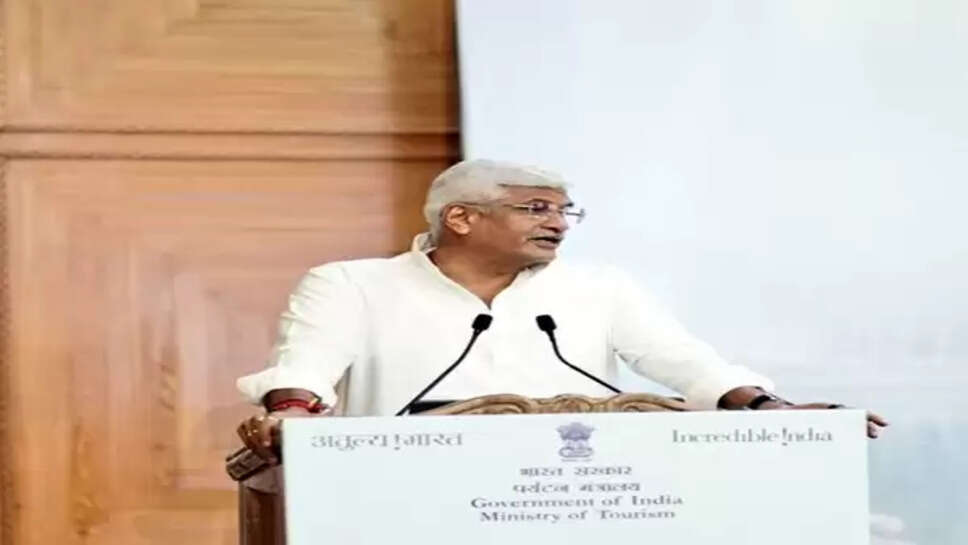Centre Targets 10% GDP Contribution from Tourism Sector

In a significant policy direction that signals India's ambitions to elevate tourism as a major economic driver, Union Minister Gajendra Singh Shekhawat recently announced the government’s intention to increase the sector’s contribution to the country’s GDP to 10%. This comes as part of a broader vision to position India as a global tourism hub, leveraging its diverse cultural, historical, ecological, and spiritual heritage to attract both domestic and international visitors.
A Vision for Economic Transformation
Tourism has long been recognized for its multiplier effect on the economy. From hospitality and transport to local artisans and small businesses, the ripple impact of tourism is substantial. Currently, tourism contributes around 5-6% to India's GDP. The Centre’s goal to raise this figure to 10% signals a massive leap — one that requires coordinated strategies, investment, and infrastructure overhaul.
According to Shekhawat, this target is not merely aspirational, but achievable. He emphasized the importance of public-private partnerships, regional connectivity, digital transformation, and sustainable practices to realize this objective.
Unlocking Untapped Potential
India is home to 40 UNESCO World Heritage sites, over 7500 km of coastline, several mountain ranges, vast deserts, lush forests, and centuries-old temples, mosques, churches, and palaces. Yet, the full potential of this cultural and geographic wealth remains underutilized. One of the key challenges has been fragmented infrastructure and inadequate last-mile connectivity to heritage and natural sites.
Minister Shekhawat stressed the need to identify and develop "tourism circuits" — integrated travel routes that connect multiple destinations with thematic or geographic relevance. For example, circuits around Buddhism, Ramayana, the Himalayas, or even coastal tourism can create compelling travel itineraries for both Indian and foreign tourists.
Infrastructure: The Backbone of Tourism
To support this ambitious expansion, investment in infrastructure is critical. This includes better roads, upgraded railways, world-class airports, and efficient public transport systems in tourist-heavy regions. Additionally, the government plans to focus on creating more budget and mid-range accommodation options, especially in tier-2 and tier-3 cities, to make tourism more accessible.
Tourism-specific infrastructure, such as information kiosks, signage in multiple languages, clean public toilets, waste management systems, and digital guides, are also in the pipeline. The Ministry is also working closely with the Ministry of Civil Aviation and Indian Railways to ensure integrated travel experiences.
Rural and Heritage Tourism in Focus
One of the most promising avenues of growth lies in promoting rural and heritage tourism. With growing global interest in authentic, off-the-beaten-path travel, India’s villages offer a wealth of experiences — from folk art and handicrafts to traditional cuisine and eco-tourism.
Shekhawat highlighted the importance of community-led tourism. By involving locals in homestay programs, cultural demonstrations, and guided tours, rural tourism can become a new engine for employment and entrepreneurship in underdeveloped areas. This approach not only empowers communities but also ensures tourists get a deeper and more genuine cultural immersion.
Digital India Meets Smart Tourism
Digitalization is set to play a major role in this transformation. The government aims to create a centralized tourism data hub that integrates online bookings, reviews, travel itineraries, local guides, and safety alerts. AI-driven tools, augmented reality experiences at museums and monuments, and QR-code based guides in regional languages are some of the innovations being tested.
Shekhawat also pointed out that real-time feedback mechanisms, social media campaigns, and influencer collaborations will be key to repositioning India’s image in the global travel market.
Sustainability Is Key
The government’s strategy also underscores the importance of sustainable and responsible tourism. In the face of rising climate concerns and overtourism challenges, the Ministry is drafting eco-tourism guidelines and incentivizing green practices. This includes promoting electric vehicles in tourist zones, encouraging use of biodegradable products, and developing carbon-neutral destinations.
Eco-sensitive regions such as the Himalayas, Western Ghats, and the Northeast are being prioritized for sustainable tourism models, where carrying capacity assessments will determine the number of tourists allowed per season.
Skill Development and Job Creation
As tourism expands, the need for trained professionals becomes crucial. The government is collaborating with educational institutions, industry bodies, and state tourism departments to develop comprehensive skilling programs. From multilingual guides and hospitality staff to digital content creators and adventure tourism experts, the sector holds promise for lakhs of jobs.
Shekhawat noted that the tourism sector already employs over 10% of India’s workforce in some form, directly or indirectly. With the right push, this number could increase significantly, especially among youth and women in rural areas.
State-Level Initiatives and Global Promotion
Several Indian states have already launched innovative campaigns to attract tourists. Rajasthan’s focus on heritage, Kerala’s wellness branding, Goa’s beach tourism, and Sikkim’s eco-tourism models are being cited as best practices. The Centre intends to create a collaborative framework where successful regional strategies can be replicated and scaled across the country.
On the global stage, the government plans to increase India's presence in international tourism fairs, launch targeted campaigns in key source markets like Europe, Southeast Asia, and North America, and simplify visa processes through e-visas and visa-on-arrival schemes.
Challenges Ahead
While the vision is bold and inspiring, challenges abound. Safety concerns, overcrowding at popular destinations, lack of sanitation, and language barriers continue to deter some tourists. Moreover, consistent quality standards across accommodations, transport, and services remain elusive.
There’s also the question of balancing growth with conservation. Without proper regulation, rapid tourism growth can damage fragile ecosystems and cultural sites. Hence, the government is working on policy frameworks that combine incentives with strict guidelines for developers and operators.
A Transformational Moment
India stands at the cusp of a transformational moment in its tourism journey. With the right mix of vision, investment, and grassroots involvement, the sector could not only enhance GDP but also become a cultural bridge, a source of pride, and a catalyst for inclusive development.
Minister Shekhawat’s 10% target may appear ambitious at first glance, but with India's vast potential and the global rebound in travel post-pandemic, the time to act is now. By placing tourism at the heart of its economic narrative, India is not just inviting the world to visit — it’s setting the stage to be experienced, celebrated, and remembered.
